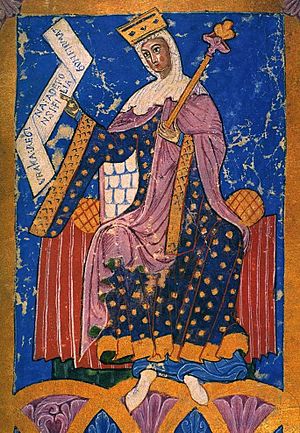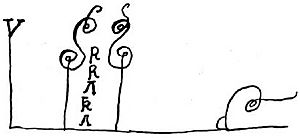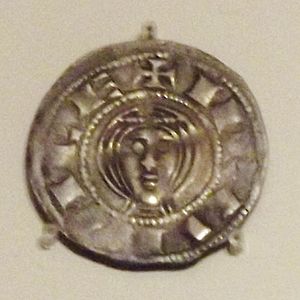Urraca of León and Castile facts for kids
Quick facts for kids Urraca |
|
|---|---|

13th-century miniature of Queen Urraca presiding at Court from Tumbo A codex
Santiago de Compostela Cathedral. |
|
| Queen of León and Castile | |
| Reign | 1109 – 1126 |
| Predecessor | Alfonso VI |
| Successor | Alfonso VII |
| Queen of Galicia | |
| Reign | 1109 – 1111 |
| Predecessor | Alfonso VI |
| Successor | Alfonso VII |
| Empress of All Spain | |
| Reign | 1109–1126 |
| Predecessor | Alfonso VI |
| Successor | Alfonso VII |
| Co-monarch | Alfonso the Battler |
| Queen consort of Aragon and Navarre | |
| Tenure | 1109 – 1114 |
| Born | 1081 Burgos |
| Died | 8 March 1126 (aged 44) Saldaña on the Río Carrión in Castilla |
| Burial | Basilica of San Isidoro |
| Spouse | Raymond of Burgundy Alfonso the Battler |
| Issue | Sancha Raimúndez Alfonso VII of León and Castile Fernando Pérez Furtado Elvira Pérez de Lara |
| House | Jiménez |
| Father | Alfonso VI of León and Castile |
| Mother | Constance of Burgundy |
| Religion | Roman Catholicism |
Urraca (around 1080 – 8 March 1126), also known as the Reckless, was a powerful queen. She ruled the kingdoms of León, Castile, and Galicia from 1109 until her death. She even called herself the Empress of All Spain and Empress of All Galicia.
Contents
Queen Urraca's Early Life
Urraca was born to King Alfonso VI of León and Castile and Constance of Burgundy. Her mother, Constance, was related to the French royal family. She was also connected to a very important church leader, Hugh of Cluny. Urraca was likely born in Sahagún or León around 1081.
Even though she was her parents' only child, not much is known about her childhood. She later mentioned two clergymen, Presbyter Pedro and Domingo Falcóniz, as her teachers. She was also very close to her aunt, Elvira of Toro. Elvira even became the guardian of Urraca's daughter, Sancha Raimúndez.
Her First Marriage and Becoming a Widow
Urraca married Raymond of Burgundy. This marriage was part of her father King Alfonso VI's plan. He wanted to make strong alliances with other European leaders. This was important after the Muslim Almoravids defeated his army in 1086.
Urraca and Raymond were first mentioned as husband and wife in 1093. They became rulers of Galicia. Raymond was in charge, but King Alfonso VI still had a lot of control. He appointed Diego Gelmírez, a clever young clergyman, to help them.
In 1093, Urraca's mother died. Then, her father had a son, Sancho Alfónsez, with another woman. This made Urraca's position as her father's only heir less certain. Her father also gave the "Land of Portugal" to her half-sister Theresa and her husband Henry.
Raymond became very sick and died in September 1107. Urraca then took full control of Galicia. She called herself "empress of whole Galicia." The leaders in Galicia wanted Urraca's young son, Alfonso Raimúndez, to be Raymond's rightful successor. King Alfonso VI agreed to this.
Sadly, Urraca's half-brother Sancho Alfónsez died in battle in May 1108. After his death, Urraca became her father's only heir again. Her new role was officially confirmed by many nobles and counts. Her father died shortly after, in July 1108.
Urraca's Time as Queen
Urraca became the first reigning queen in European history. This means she ruled in her own right, not just as a queen married to a king. Her first official document as queen called her "queen of whole Spain." Many important people supported her.
Her Second Marriage
Some nobles in León thought a woman couldn't rule alone. They wanted Urraca to marry Alfonso I, the King of Aragon and Navarre. They hoped this marriage would help defend the kingdom. However, Urraca and Alfonso were cousins, which was a problem for the church.
Alfonso I married Urraca in late 1109. Urraca gave her lands to her new husband. She also made sure that her son, Alfonso Raimúndez, would still inherit León if she and Alfonso I had no children.
However, the people of Galicia wanted more independence. They used Urraca's son, Alfonso Raimúndez, as a reason to rebel. They said Urraca had lost her right to rule Galicia by remarrying. They even declared Alfonso Raimúndez as their king.
Alfonso I and Urraca went to Galicia with their army. They captured a castle, but the Aragonese troops were very harsh. This made the nobles in León angry. The relationship between Alfonso I and the church leaders also became difficult.
The marriage was not happy. Alfonso I was known for being prejudiced against women. He also disliked Urraca's son. Urraca found her husband superstitious and cruel. He often treated her badly in public. Urraca soon wanted to end the marriage. She started calling herself "queen of whole Spain and daughter of Emperor Alfonso" in her documents.
The marriage of Urraca and Alfonso caused many problems. There were rebellions in Galicia. Her half-sister Theresa and her husband Henry of Portugal also caused trouble. They worried that Urraca's new marriage would hurt her son Alfonso Raimúndez's rights.
Urraca and Alfonso I had signed an agreement. It said they would share power over each other's kingdoms. It also said their future children would inherit both kingdoms. If they had no children, the one who lived longer would inherit the other's throne.
In Galicia, there were two main groups against the marriage. One group, led by Archbishop Diego Gelmírez, wanted Alfonso Raimúndez to be Urraca's successor. The other group, led by Count Pedro Fróilaz de Traba, wanted Galicia to be completely independent under Alfonso. A third group at court was led by Count Gómez González. He feared losing power, especially as Alfonso I started giving important jobs to Aragonese and Navarrese nobles.
Count of Traba started the first fight in Galicia. He demanded Alfonso Raimúndez's rights. Alfonso I marched his army to Galicia and restored order in 1110. But this was just the start of many conflicts. Urraca and Alfonso I had very different personalities and disliked each other. This led to a long civil war in the kingdoms. Urraca did not share the rule of her kingdoms with her husband.
As their relationship worsened, Urraca accused Alfonso of mistreatment. By May 1110, she separated from him. She also disagreed with how Alfonso handled rebels. He executed a rebel who had surrendered to Urraca, and she wanted to be merciful. Also, many people in the kingdom did not like Urraca's marriage. Her son became a symbol for those who opposed the marriage.
The disagreements between Urraca and Alfonso grew into open warfare. Alfonso of Aragon and Henry of Portugal formed an alliance. In 1111, Urraca's main supporter, Gómez González, was killed in the Battle of Candespina. Another count, Pedro González de Lara, soon took his place. He also had children with Urraca.
By late 1112, a truce was made, and their marriage was ended. Urraca got back Asturias, León, and Galicia. But Alfonso still held parts of Castile. Her half-sister Theresa and Henry of Portugal took over Zamora and Extremadura. Urraca spent much of her time trying to get these regions back and expand into Muslim lands.
Urraca also had to deal with her sister Theresa's plans. Theresa wanted to replace Urraca with her son. This conflict ended with a compromise. Theresa was given a large territory in León, and she agreed to be Urraca's vassal.
Historians say that Urraca's success was her ability to protect her father's kingdom. She also passed it on completely to her son. Her father's actions, like allowing her half-sister to claim part of the kingdom and forcing her to marry Alfonso I, created many challenges for Urraca. But Urraca used her position as a woman to her advantage in politics and diplomacy.
Queen Urraca's Character
The Historia Compostelana, a historical text, describes Urraca as wise, modest, and sensible. However, it also says her "failings" were due to her being a woman. It even called her a "Jezebel" because of her relationships with important nobles. But historians note that Urraca was very much in control of events.
Her Death and Legacy
As queen, Urraca faced many challenges. She found practical solutions to them. Her actions helped prepare the kingdom for her son, Alfonso VII. Despite some opposition, Alfonso VII inherited a united and peaceful kingdom when Urraca died in 1126.
Urraca's reign also set an important example. It created a legal precedent for future queens to rule in their own right.
Urraca's Family
Urraca's first child with Raymond, Sancha, was born before November 1095. She was named after Urraca's grandmother, Sancha of León. Her second child, Alfonso, was born around 1105. He was named after Urraca's father.
Urraca had two children with Pedro González de Lara: Fernando Pérez Hurtado (born around 1114) and Elvira Pérez de Lara (born around 1112). Elvira is mentioned in the Historia Compostelana for giving the village of Arquillinos to Diego Gelmírez. Elvira married twice. First to García Pérez de Traba, and then to Count Beltrán de Risnel.
See also
 In Spanish: Urraca I de León para niños
In Spanish: Urraca I de León para niños



